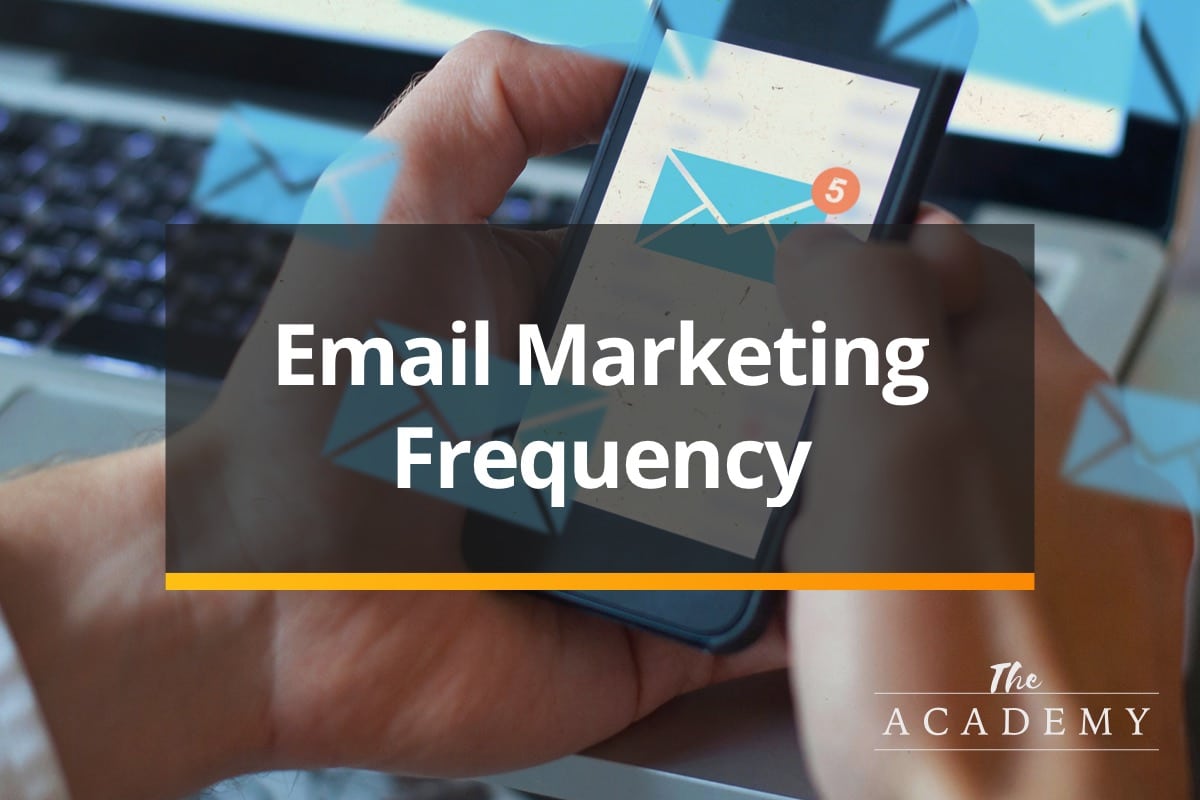
Email marketing is a powerful tool in the arsenal of your marketing tactics. It offers a platform for direct communication with your audience, allowing you to build relationships, educate, promote your products, and ultimately drive sales. Email as a tactic can mean a lot of different things to people. How to do it all well is nuanced. So today let’s talk specifically about the importance of email marketing frequency and how to optimize it for the best results.
Email Marketing is a proven, effective tactic
Email marketing is an incredibly effective tactic for small businesses that can play a vital role in their growth and success. Recent studies have highlighted the widespread reliance on email as both a customer acquisition channel and a means of retention among SMBs. According to Emarsys (2019), a staggering 81% of small businesses use email as their primary customer acquisition tool, recognizing its power in reaching and engaging with potential customers.
Moreover, it is not just about acquiring new customers but also retaining existing ones. The same study by Emarsys reveals that 80% of SMBs leverage email marketing for customer retention purposes. This demonstrates the enduring value that businesses place on nurturing relationships with their loyal client base through targeted emails.
The effectiveness of email marketing can also be measured in terms of return on investment (ROI). Data from multiple industry reports show an impressive average return of $42 for every $1 spent on email marketing efforts. This compelling statistic underscores the financial benefits that small businesses can reap by implementing well-crafted email campaigns.
The statistics don’t lie – Some key takeaways
A myriad of statistics underlines the potency of this marketing strategy. The widespread use of email, with over 4 billion people using it across the globe, opens a vast potential audience for businesses. The numbers further indicate that a staggering 81% of small businesses rely on email as their primary customer acquisition channel (Emarsys, 2019). These positive statistics collectively underscore the effectiveness and potential of email marketing.
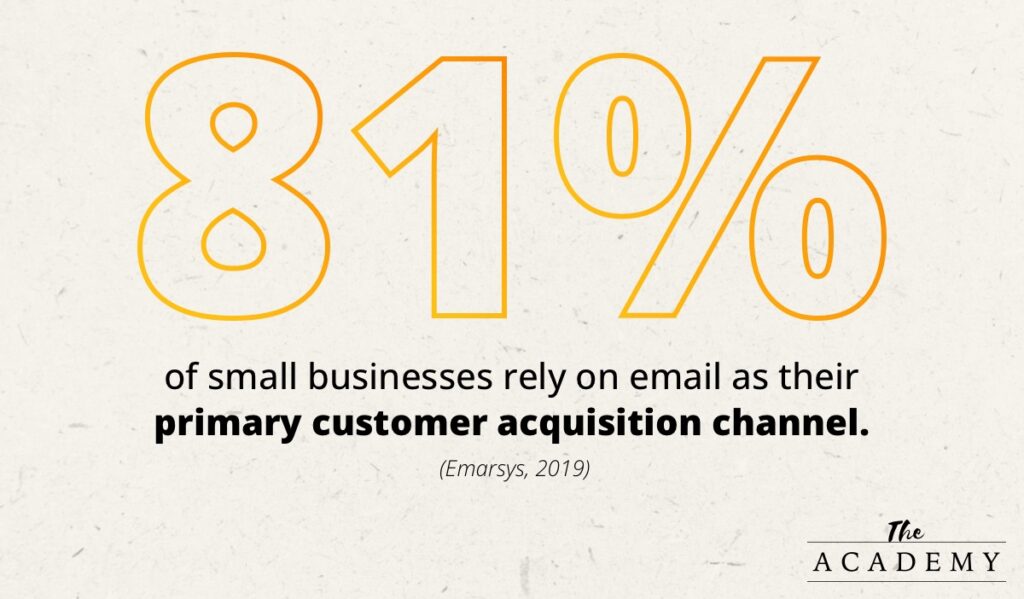
If you’d like to dive deep into more of the supporting statistics, consider exploring the information provided in this insightful article by Hubspot around email marketing statisics. Below are just a few of the key takeaways that you can learn more about.
- Email marketing is alive and thriving, with billions of users and growing budgets.
- Mobile-friendliness is essential for reaching engaged audiences.
- Personalization and segmentation are key to boosting email performance.
- Track key metrics like open rates, clickthrough rates, and click rates.
- A/B testing and automation can significantly improve campaign results.
- Focus on building engagement through valuable content and interactions.
- Optimize email design with effective visuals like images.
- Choose email providers with high delivery rates for optimal reach.
- Email offers a high ROI, making it a cost-effective marketing tool.
- Continuously refine your email strategy based on data and insights.
Email marketing is a powerful tool for small business owners, but it’s important to recognize that there are nuances within this strategy that can greatly influence its effectiveness. How often you send emails is only one of them. These subtle yet essential elements should not be overlooked if you want your email marketing campaign to succeed.
On that note, let’s begin to focus the conversation on the topic at hand – frequency.
Risks of Emailing Too Often
Maintaining a consistent line of communication with your audience is undeniably important for any successful email marketing campaign. However, striking the right balance and avoiding overwhelming your recipients with an excessive number of emails is equally crucial. The consequences of sending emails too frequently can be detrimental to both your brand reputation and the effectiveness of your campaign.
A study conducted by TechnologyAdvice shed light on this issue, revealing that a staggering 45.8% of surveyed individuals reported flagging emails as spam simply because they were bombarded with an excessive volume from a single sender. This alarming statistic underscores the negative perception that arises when recipients feel overwhelmed or inundated by constant email notifications — even if they’re legitimately subscribed.
Excessive emailing can lead to what industry professionals refer to as “list attrition.” When individuals receive an influx of messages from a particular sender, it often prompts them to take action in order to regain control over their inbox. Consequently, people may choose to opt-out entirely from receiving further communications from such senders. In fact, the same study found that 43% of respondents expressed their desire for businesses to reduce the frequency at which they send promotional emails.
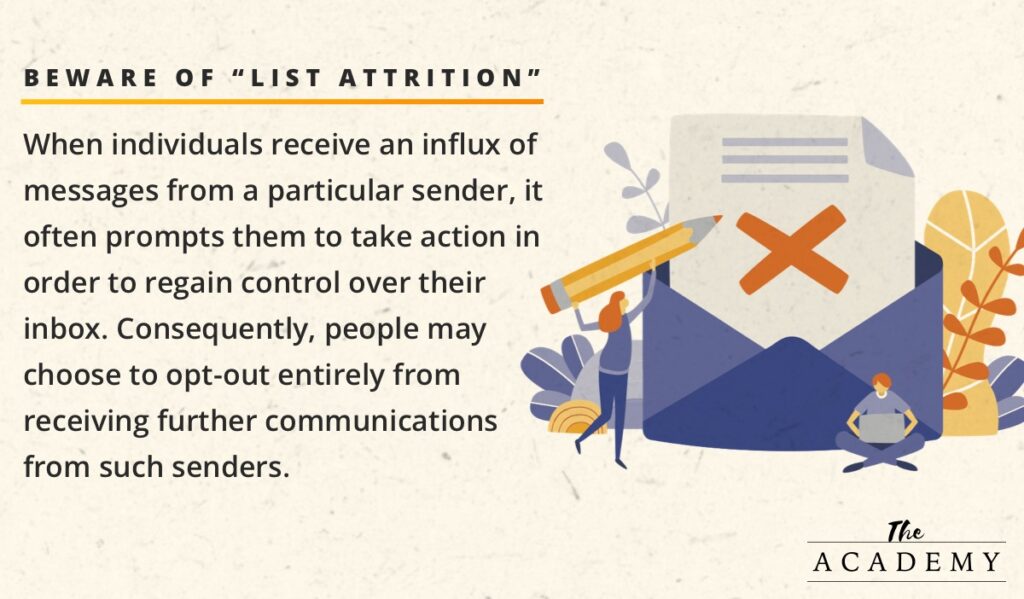
Essentially, customers want and need to stay connected to brands, but they don’t want to be annoyed by brands.
These findings highlight the importance not only of establishing effective frequency guidelines but also of respecting and valuing subscribers’ preferences and boundaries when it comes to email communication. By striking a delicate balance between maintaining regular contact and avoiding overwhelming recipients with incessant messages, businesses can foster stronger relationships built on trust while maximizing engagement rates among their target audience.
Email Marketing Frequency: Tips for Success
Finding the right balance in email marketing frequency is key to maintaining customer engagement without driving them away. Success is going to require a little bit of sophistication. Here are ten key tips for succeeding with email marketing frequency:
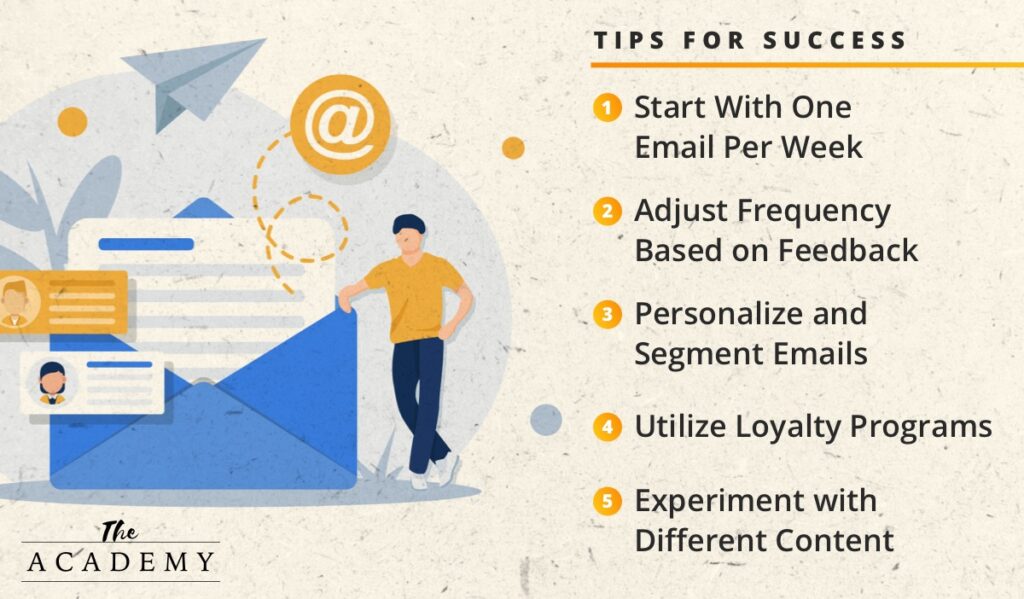
Start With One Email Per Week:
“A journey of a thousand miles begins with a single step.” – Lao Tzu
By starting with a moderate frequency of one email per week, you give your audience enough time to digest and engage with your content without feeling bombarded.
It’s important not to stick rigidly to this schedule without considering how your subscribers are responding. Pay close attention to metrics such as open rates, click-through rates, and conversion rates. These indicators will provide valuable insights into whether the current frequency is resonating well with your audience or if adjustments need to be made.
If you notice positive engagement metrics consistently improving over time, it might be an indication that increasing the email frequency could be beneficial. Gradually adding more emails in a strategic manner can help maintain interest levels while providing additional value through targeted content or promotions.
Conversely, if you observe declining engagement metrics or receive feedback from subscribers expressing discontent with the current frequency of emails received, it’s essential to reevaluate your strategy. Consider reducing the number of weekly emails or implementing segmentation strategies that allow subscribers more control over what types of content they receive and at what cadence.
Adjust Frequency Based on Feedback:
Monitoring open rates and unsubscribe rates is crucial in determining how your audience is reacting to the frequency of your email marketing activities. By keeping a close eye on these metrics, you can gain valuable insights into whether your subscribers find your emails engaging or overwhelming.
Open rates indicate how many recipients are actually opening and reading your emails. A high open rate indicates that your content resonates with the audience, capturing their attention and encouraging them to explore further. On the other hand, a low open rate may suggest that either the subject line fails to pique interest or the frequency of emails is too high for subscribers to keep up with.
Another essential metric to consider is unsubscribe rates. This metric reflects the number of individuals who opt out of receiving future communications from you. If you notice a sudden increase in unsubscribes after sending out an email campaign, it could be a sign that you are bombarding your audience with excessive messages, causing them to lose interest or feel overwhelmed.
Personalize and Segment Emails:
“Treat your customers like guests, not targets.” – Chipotle founder Steve Ells
A study by MailChimp showed that segmented campaigns had 14.31% higher open rates than non-segmented campaigns.
Personalized emails have become an essential tool in maximizing engagement and driving successful email marketing campaigns. In order to effectively engage with your subscribers, it is crucial to tailor your emails to their individual preferences and behaviors.
By personalizing your emails, you can create a more meaningful connection with each subscriber. Understanding the unique characteristics of your audience allows you to deliver content that resonates with them on a deeper level. This could include personalized product recommendations based on their browsing or purchase history, customized offers aligned with their interests, or even special birthday greetings tailored specifically for them.
Segmentation can help you to personalize your emails because it can match content to what each unique group desires. Some segments may prefer frequent updates while others may appreciate less frequent but more comprehensive newsletters. By identifying these variances within your subscriber base, you can avoid overwhelming recipients with excessive emails or missing out on opportunities by not reaching out often enough.
Utilize Loyalty Programs:
By implementing a well-designed loyalty program within your email marketing efforts, you can provide exclusive benefits that resonate with your customers’ preferences and purchasing behaviors. These benefits may include special discounts, early access to new products or services, freebies or samples, or even personalized product recommendations based on their past purchases.
The key advantage of incorporating loyalty programs into your email marketing approach is twofold: not only does it incentivize customers to continue engaging with your brand but also enables you to gather valuable data about their preferences and shopping habits. This data can then be leveraged to refine future email campaigns further.
Experiment with Different Content:
“I would say, as an entrepreneur everything you do – every action you take in product development, in marketing, every conversation you have, everything you do – is an experiment. If you can conceptualize your work not as building features, not as launching campaigns, but as running experiments, you can get radically more done with less effort.”
– Eric Ries
By experimenting with different formats, topics, or styles of communication in your emails, you can gain valuable insights into what resonates most strongly with your subscribers. This testing phase allows you to identify the type of content that generates higher open rates, click-through rates, and ultimately drives conversions.
Understanding the preferences and interests of your audience is key in tailoring your email campaigns for success. Through careful analysis and monitoring metrics such as engagement levels or feedback received from subscribers, you can uncover which types of content are truly captivating them.
By regularly assessing these results over time rather than relying on assumptions or guesswork about what might work best for each individual recipient within your mailing list, you can refine your strategy accordingly. Constantly adapting and refining based on data-driven insights ensures that you consistently deliver relevant and compelling content that keeps subscribers eagerly anticipating their next interaction with your brand.
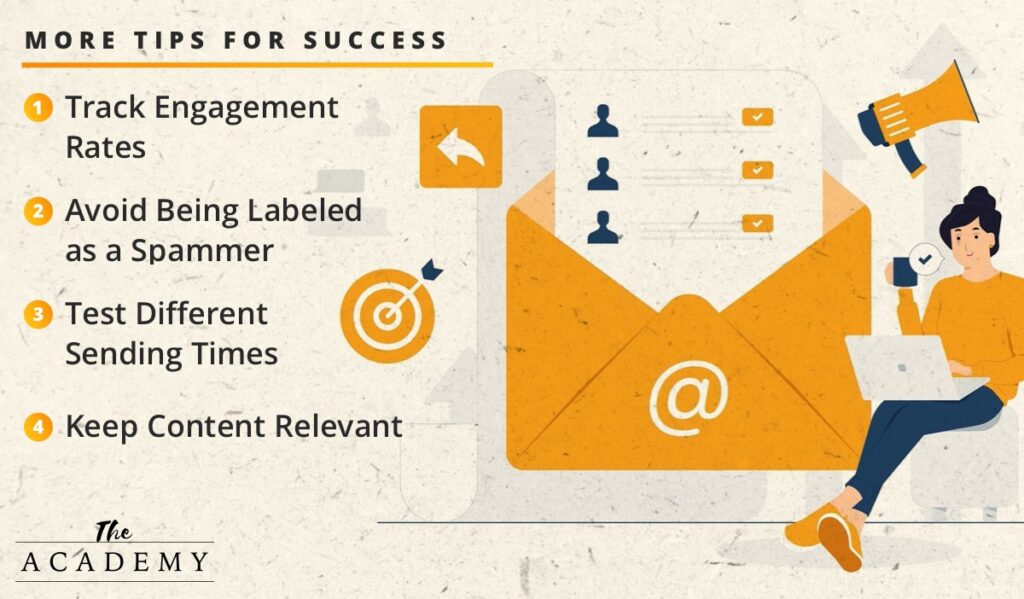
Track Engagement Rates:
Regularly tracking engagement rates is essential in determining the effectiveness of your email marketing strategy. By closely monitoring how recipients are interacting with your emails, you can gain valuable insights into whether your current frequency aligns with their preferences and expectations. Engagement rates provide a comprehensive overview of how well your emails are resonating with your audience, helping you make informed decisions on adjusting the frequency of your campaigns.
These metrics allow you to evaluate key aspects such as open rates, click-through rates, and conversion rates. Open rates indicate the percentage of recipients who open and view your emails, providing an initial indication of interest or relevance.
Click-through rates measure the number of individuals who clicked on links within your emails, demonstrating active engagement and potential interest in exploring further. Conversion rates highlight the ultimate goal – how many recipients take desired actions after being prompted by an email campaign.
By regularly analyzing these engagement metrics over time, patterns may emerge that shed light on optimal email frequency for maximum impact.
Avoid Being Labeled as a Spammer:
“Spam is the roach motel of the internet. Nobody checks in, but everyone wants to check out.” – Jerry Seinfeld
There’s always the risk of recipients flagging your emails as spam, which not only hampers your brand reputation but also diminishes the effectiveness of your overall email marketing strategy. This delicate equilibrium lies at the intersection between maintaining customer engagement and avoiding overwhelming or annoying them. But there are many things that you can do to ensure that you’re not specifically flagged as a spammer.
One of the most crucial things that you can do is to always ensure you have permission to email the people on your list. This usually means they’ve opted-in or subscribed to your emails. A good way to accomplish this is by employing double opt-in methods, which require new subscribers to confirm their email address before being added to your list. This approach not only helps verify the email address but also confirms that the owner of the email address is interested in receiving your emails.
Next, using a reliable Email Service Provider (ESP) is another essential step. ESPs like Hubspot, MailChimp, or Constant Contact have built strong relationships with email service providers (Gmail, Yahoo, Outlook, etc.) to ensure your emails are delivered to the inbox, not the spam folder. They also provide tools for managing your email list and complying with email regulations, further reducing the chances of being marked as spam.
You can also work to avoid spammy language in your subject lines and email content. This can significantly reduce the risk of being flagged as spam. Words and phrases like ‘free’, ‘buy now’, ‘promo’, etc., can trigger spam filters, leading to your emails being automatically categorized as spam.
Regularly cleaning your email list to remove unengaged subscribers is also a good practice. High bounce rates and low engagement rates can hurt your sender reputation, increasing the likelihood of your emails being marked as spam. Offering a clear and easy way to unsubscribe can help maintain a healthy and engaged email list, further improving your sender reputation.
Test Different Sending Times:
The time of day at which you hit that “send” button can have a profound impact on your open rates and ultimately determine the success of your campaigns. To maximize engagement with your subscribers, it is crucial to find that sweet spot when they are most likely to read and interact with your emails.
The key lies in understanding the behavior patterns and preferences of your target audience. Every segment will likely have their own unique routines and habits when it comes to checking their inbox. By testing different sending times, you can gather valuable insights into their email consumption habits.
Again, experimentation is key in this process. Try sending emails at various times throughout the day – during morning hours when people are just starting their workday, during lunch breaks or commuting hours, or even late in the evening when individuals unwind from their busy schedules. Analyze how these different time slots affect open rates by monitoring metrics such as click-through rates and conversions.
Additionally, consider segmenting your email list based on factors like geographical location or demographic information. This way, you can tailor specific send times for each group depending on where they reside or what stage of life they’re in – ensuring maximum relevance and effectiveness.
Keep Content Relevant:
“Marketing that’s not relevant is like throwing a party and nobody coming.” – Marketo
You must ensure that the content you send is always relevant to your audience. In today’s fast-paced digital world, where people are inundated with countless emails daily, providing real value and pertinent information is extremely important. By tailoring your email content to align with the interests and needs of your subscribers, you can significantly increase open rates while simultaneously reducing unsubscribe rates.
When recipients receive emails that contain irrelevant or uninteresting content, they may quickly lose interest and choose not to engage further. If subscribers consistently find little value in what you provide them, it’s only natural for them to become disengaged over time.
Including relevant content in your emails — starting with the subject line — raises your success rates and reduces how many people unsubscribe. When individuals don’t see value in the messages that you send, they might opt out from receiving future communications altogether. A strong emphasis on delivering meaningful and targeted content ensures a more positive user experience by fostering a sense of relevance within every interaction.
Email marketing is a valuable tool for small businesses and marketers, but understanding its nuances, particularly around frequency, is crucial for its success. By finding the right balance in email frequency and personalizing your emails effectively, you can maximize engagement and conversion rates. Implementing these strategies can significantly enhance your email marketing efforts and contribute to your business’s growth and success.
For more about email marketing, pleas read, listen and watch here.
Most Popular Articles

Seeing Favicons in Your Google Search Results? Here’s Why…
Have you noticed anything different in your Google Search results lately? Google added tiny favicon icons to its organic search results in January. It was…

Business Growth and Digital Marketing News & Tips 11-17-24
Are you encouraging and rewarding innovation? Lee Cockerell is the former Executive Vice President of Operations at Walt Disney World. A lover of traditional red…

Business Growth and Digital Marketing News & Tips 11-27-24
A culture of gratitude "Feeling gratitude and not expressing it is like wrapping a present and not giving it." – William Arthur Ward Beyond being…








